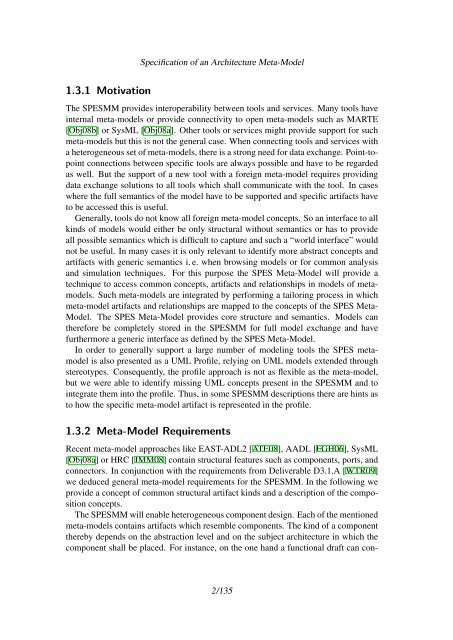Specification of an Architecture Meta-Model - SPES 2020
Specification of an Architecture Meta-Model - SPES 2020
Specification of an Architecture Meta-Model - SPES 2020
You also want an ePaper? Increase the reach of your titles
YUMPU automatically turns print PDFs into web optimized ePapers that Google loves.
1.3.1 Motivation<br />
<strong>Specification</strong> <strong>of</strong> <strong>an</strong> <strong>Architecture</strong> <strong>Meta</strong>-<strong>Model</strong><br />
The <strong>SPES</strong>MM provides interoperability between tools <strong>an</strong>d services. M<strong>an</strong>y tools have<br />
internal meta-models or provide connectivity to open meta-models such as MARTE<br />
[Obj08b] or SysML [Obj08a]. Other tools or services might provide support for such<br />
meta-models but this is not the general case. When connecting tools <strong>an</strong>d services with<br />
a heterogeneous set <strong>of</strong> meta-models, there is a strong need for data exch<strong>an</strong>ge. Point-topoint<br />
connections between specific tools are always possible <strong>an</strong>d have to be regarded<br />
as well. But the support <strong>of</strong> a new tool with a foreign meta-model requires providing<br />
data exch<strong>an</strong>ge solutions to all tools which shall communicate with the tool. In cases<br />
where the full sem<strong>an</strong>tics <strong>of</strong> the model have to be supported <strong>an</strong>d specific artifacts have<br />
to be accessed this is useful.<br />
Generally, tools do not know all foreign meta-model concepts. So <strong>an</strong> interface to all<br />
kinds <strong>of</strong> models would either be only structural without sem<strong>an</strong>tics or has to provide<br />
all possible sem<strong>an</strong>tics which is difficult to capture <strong>an</strong>d such a “world interface” would<br />
not be useful. In m<strong>an</strong>y cases it is only relev<strong>an</strong>t to identify more abstract concepts <strong>an</strong>d<br />
artifacts with generic sem<strong>an</strong>tics i. e. when browsing models or for common <strong>an</strong>alysis<br />
<strong>an</strong>d simulation techniques. For this purpose the <strong>SPES</strong> <strong>Meta</strong>-<strong>Model</strong> will provide a<br />
technique to access common concepts, artifacts <strong>an</strong>d relationships in models <strong>of</strong> metamodels.<br />
Such meta-models are integrated by performing a tailoring process in which<br />
meta-model artifacts <strong>an</strong>d relationships are mapped to the concepts <strong>of</strong> the <strong>SPES</strong> <strong>Meta</strong>-<br />
<strong>Model</strong>. The <strong>SPES</strong> <strong>Meta</strong>-<strong>Model</strong> provides core structure <strong>an</strong>d sem<strong>an</strong>tics. <strong>Model</strong>s c<strong>an</strong><br />
therefore be completely stored in the <strong>SPES</strong>MM for full model exch<strong>an</strong>ge <strong>an</strong>d have<br />
furthermore a generic interface as defined by the <strong>SPES</strong> <strong>Meta</strong>-<strong>Model</strong>.<br />
In order to generally support a large number <strong>of</strong> modeling tools the <strong>SPES</strong> metamodel<br />
is also presented as a UML Pr<strong>of</strong>ile, relying on UML models extended through<br />
stereotypes. Consequently, the pr<strong>of</strong>ile approach is not as flexible as the meta-model,<br />
but we were able to identify missing UML concepts present in the <strong>SPES</strong>MM <strong>an</strong>d to<br />
integrate them into the pr<strong>of</strong>ile. Thus, in some <strong>SPES</strong>MM descriptions there are hints as<br />
to how the specific meta-model artifact is represented in the pr<strong>of</strong>ile.<br />
1.3.2 <strong>Meta</strong>-<strong>Model</strong> Requirements<br />
Recent meta-model approaches like EAST-ADL2 [ATE08], AADL [FGH06], SysML<br />
[Obj08a] or HRC [JMM08] contain structural features such as components, ports, <strong>an</strong>d<br />
connectors. In conjunction with the requirements from Deliverable D3.1.A [WTR09]<br />
we deduced general meta-model requirements for the <strong>SPES</strong>MM. In the following we<br />
provide a concept <strong>of</strong> common structural artifact kinds <strong>an</strong>d a description <strong>of</strong> the composition<br />
concepts.<br />
The <strong>SPES</strong>MM will enable heterogeneous component design. Each <strong>of</strong> the mentioned<br />
meta-models contains artifacts which resemble components. The kind <strong>of</strong> a component<br />
thereby depends on the abstraction level <strong>an</strong>d on the subject architecture in which the<br />
component shall be placed. For inst<strong>an</strong>ce, on the one h<strong>an</strong>d a functional draft c<strong>an</strong> con-<br />
2/135
















